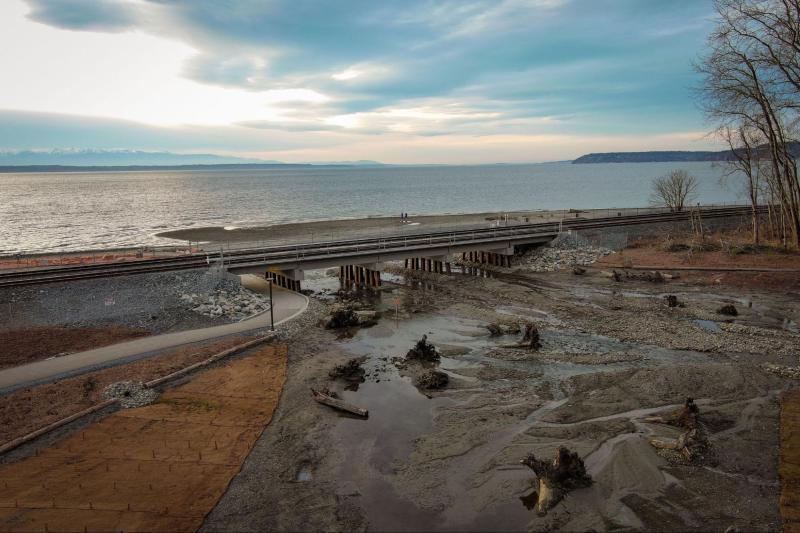For many years, visitors to Meadowdale Beach Park in Edmonds, Washington, often found it difficult to actually access the beach. A railroad runs along the shoreline, and a too-narrow concrete culvert was the only opening for both people and salmon to travel under the railway. A NOAA-supported project has helped reconnect the park to the beach and restore much-needed habitat for salmon.
Restoring Habitat for Salmon
Estuaries—where rivers meet the sea—serve as important habitat for migratory fish. They provide refuge from predators, nurseries for young fish to grow, opportunities for feeding, and places to rest and adjust to salt water during migration.
Historically, Meadowdale Beach Park was home to a small estuary where Lunds Gulch Creek flows into Puget Sound. But when the railroad was built and the concrete culvert installed, it restricted the flow of the creek. This impaired its natural stream processes and degraded the estuary habitat. The small size of the culvert also increased the speed of water flowing through it. At times, the flows were too fast for salmon to swim upstream.
Snohomish County led the effort to replace the culvert with a new bridge, in partnership with BNSF Railway, Tulalip Tribes, state and federal agencies, and the local community. The bridge widened the connection between Lunds Gulch Creek and Puget Sound, helping improve fish passage and restore the natural flow of the stream.
To supplement the culvert replacement, NOAA provided $300,000 in funding to restore 1.3 acres of estuary habitat just upstream of the new bridge. The restored estuary will provide important rearing habitat for young Chinook salmon, which are listed as threatened under the Endangered Species Act. It will also support other migratory species such as coho and chum salmon, and steelhead and cutthroat trout.
Improving Public Access
Prior to restoration, park visitors hoping to travel to the beach faced accessibility and public safety challenges. The only path between the park and beach required using the culvert to pass underneath the railroad tracks. The culvert tunnel required walking along a narrow ledge, making the path inaccessible for visitors with limited mobility. The tunnel also often flooded during heavy rainfall, blocking off access completely. Some visitors would instead attempt to trespass over the tracks, posing a significant public safety risk.
When project partners installed the new bridge, they also added a new accessible walkway to the beach. A pedestrian path and footbridge now curves along the new estuary habitat and over the creek, with a platform for viewing salmon. Other improvements and amenities, including picnic benches, new restrooms, and interpretive signage, have helped revitalize the park.
Partnership Provides Path Forward
This project was the first of its kind to widen a stream crossing under railroad tracks along the Puget Sound shoreline. The collaborative partnership between many different partners, including BNSF Railway, was instrumental in its success. Railroad tracks line many miles of shoreline in the region, creating similar difficulties for habitat and salmon where they cross rivers and streams. This project provides a framework for implementing similar restoration projects in the future.





